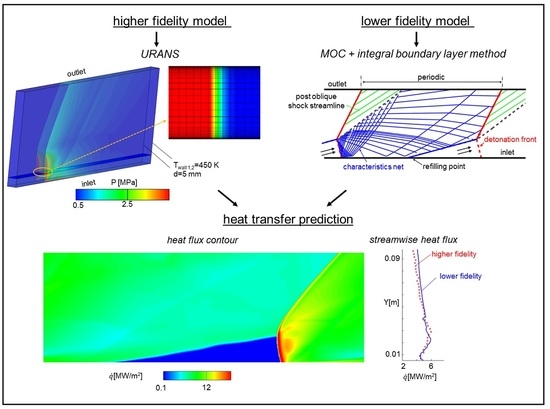Numerical Assessment of the Convective Heat Transfer in Rotating Detonation Combustors Using a Reduced-Order Model
Abstract
:1. Introduction
2. Aero–Thermal Modeling of Rotating Detonation Combustors
2.1. Unsteady Reynolds-Averaged Navier–Stokes Evaluation
2.2. Reduced-Order Model Based on the Method of Characteristics
2.3. Heat-Transfer Analysis: URANS vs. Reduced-Order Model with Heat-Flux Correlation
2.4. Limitations of the Reduced-Order Model
3. Results
3.1. Navier–Stokes Solution vs. Reduced-Order Model
3.2. Parametric Study
4. Conclusions
Author Contributions
Acknowledgments
Conflicts of Interest
Nomenclature
| D | diffusivity constant (m2 s−1) |
| kref | reference thermal conductivity (W/(m·K)] |
| H | characteristic mesh size (m) |
| M | Mach number (-) |
| P | pressure (Pa) |
| T | temperature (K) |
| P0,gain | mass-flow-averaged pressure gain (-) |
| V | velocity in absolute frame of reference (ms−1) |
| W | velocity in frame of reference of the detonation wave (m−1) |
| U | detonation wave speed (ms−1) |
| q | heat flux (W m−2) |
| h | convective heat-transfer coefficient (WK−1m−2) |
| Q | dependent variables |
| source terms | |
| inviscid flux vectors | |
| viscous flux vectors | |
| momentum thickness (-) | |
| ρ | density (kg/m3) |
| σ | mass fraction (-) |
| σviscosity,ref | reference viscosity (kg/(m·s)) |
| τ | shear stress (kg/(m2·s)) |
| heat flux (J/(kg·K)) | |
| mass rate per unit volume of production (kg m−3 s−1) |
Subscripts
| 0 | total quantities |
| e | at exit of the boundary layer |
| w | wall |
| a | adiabatic |
Abbreviations
| URANS | Unsteady Reynolds-averaged Navier–Stokes |
| RDC | Rotating detonation combustor |
| MOC | Method of characteristics |
References
- Sousa, J.; Paniagua, G.; Morata, E.C. Thermodynamic analysis of a gas turbine engine with a rotating detonation combustor. Appl. Energy 2017, 195, 247–256. [Google Scholar] [CrossRef]
- Roy, A.; Ferguson, D.H.; Sidwell, T.; O’Meara, B.; Strakey, P.; Bedick, C.; Sisler, A. Experimental study of rotating detonation combustor performance under preheat and back pressure operation. In Proceedings of the 55th AIAA Aerospace Sciences Meeting, Grapevine, TX, USA, 9–13 January 2017; p. 1065. [Google Scholar]
- Andrus, I.Q.; King, P.I.; Polanka, M.D.; Schauer, F.R.; Hoke, J.L. Experimentation of a premixed rotating detonation engine utilizing a variable slot feed plenum. In Proceedings of the 54th AIAA Aerospace Sciences Meeting, San Diego, CA, USA, 4–8 January 2016. [Google Scholar]
- Anand, V.; St. George, A.; Farbos de Luzan, C.; Gutmark, E. Rotating detonation wave mechanics through ethylene-air mixtures in hollow combustors, and implications to high frequency combustion instabilities. Exp. Therm. Fluid Sci. 2018, 92, 314–325. [Google Scholar] [CrossRef]
- Nakagami, S.; Matsuoka, K.; Kasahara, J.; Kumazawa, Y.; Fujii, J.; Matsuo, A.; Funaki, I. Experimental Visualization of the Structure of Rotating Detonation Waves in a Disk-Shaped Combustor. J. Propuls. Power 2017, 33, 80–88. [Google Scholar] [CrossRef]
- Frolov, S.; Aksenov, V.; Ivanov, V.; Shamshin, I. Large-scale hydrogen–air continuous detonation combustor. Int. J. Hydrog. Energy 2015, 40, 1616–1623. [Google Scholar] [CrossRef]
- Le Naour, B.; Falempin, F.H.; Coulon, K. MBDA R&T Effort Regarding Continuous Detonation Wave Engine for Propulsion—Status in 2016. In Proceedings of the 21st AIAA International Space Planes and Hypersonics Technologies Conference, International Space Planes and Hypersonic Systems and Technologies Conferences, Xiamen, China, 6–9 March 2017. [Google Scholar]
- Davidenko, D.M.; Gokalp, I.; Kudryavtsev, A.N. Numerical study of the continuous detonation wave rocket engine. In Proceedings of the 15th AIAA International Space Planes and Hypersonic Systems and Technologies Conference, Dayton, OH, USA, 28 April–1 May 2008. [Google Scholar]
- Zheng, H.; Qi, L.; Zhao, N.; Li, Z.; Liu, X. A Thermodynamic Analysis of the Pressure Gain of Continuously Rotating Detonation Combustor for Gas Turbine. Appl. Sci. 2018, 8, 535. [Google Scholar] [CrossRef]
- Cocks, P.A.; Holley, A.T.; Rankin, B.A. High fidelity simulations of a non-premixed rotating detonation engine. In Proceedings of the 54th AIAA Aerospace Sciences Meeting, San Diego, CA, USA, 4–8 January 2016. [Google Scholar]
- Frolov, S.; Dubrovskii, A.; Ivanov, V. Three-dimensional numerical simulation of operation process in rotating detonation engine. Proc. Prog. Propuls. Phys. EDP Sci. 2013, 4, 467–488. [Google Scholar]
- Zhou, R.; Wang, J.-P. Numerical Investigation of Flow Particle Paths and Thermodynamic Performance of Continuously Rotating Detonation Engines. Combust. Flame 2012, 159, 3632–3645. [Google Scholar] [CrossRef]
- Schwer, D.; Kailasanath, K. Numerical investigation of the physics of rotating-detonation-engines. Proc. Combust. Inst. 2011, 33, 2195–2202. [Google Scholar] [CrossRef]
- Braun, J.; Saracoglu, B.H.; Paniagua, G. Unsteady Performance of Rotating Detonation Engines with Different Exhaust Nozzles. J. Propuls. Power 2016, 33, 121–130. [Google Scholar] [CrossRef]
- Braun, J.; Saracoglu, B.H.; Magin, T.E.; Paniagua, G. One-Dimensional Analysis of the Magnetohydrodynamic Effect in Rotating Detonation Combustors. AIAA J. 2016, 54, 3761–3767. [Google Scholar] [CrossRef]
- Ornano, F.; Braun, J.; Saracoglu, B.H.; Paniagua, G. Multi-stage nozzle-shape optimization for pulsed hydrogen–air detonation combustor. Adv. Mech. Eng. 2017, 9, 1–9. [Google Scholar] [CrossRef]
- Eude, Y.; Davidenko, D.M.; Gokalp, I.; Falempin, F. Use of the adaptive mesh refinement for 3D simulations of a CDWRE (continuous detonation wave rocket engine). In Proceedings of the 17th AIAA International Space Planes and Hypersonic Systems and Technologies Conference, San Francisco, CA, USA, 13 April 2011. [Google Scholar]
- Mizener, A.R.; Lu, F.K. Low-Order Parametric Analysis of a Rotating Detonation Engine in Rocket Mode. J. Propuls. Power 2017, 33, 1543–1554. [Google Scholar] [CrossRef]
- Fievisohn, R.T.; Yu, K.H. Steady-State Analysis of Rotating Detonation Engine Flow fields with the Method of Characteristics. J. Propuls. Power 2016, 33, 89–99. [Google Scholar] [CrossRef]
- Sousa, J.; Braun, J.; Paniagua, G. Development of a fast evaluation tool for rotating detonation combustors. Appl. Math. Model. 2017, 52, 42–52. [Google Scholar] [CrossRef]
- Roy, A.; Bedick, C.; Strakey, P.; Sidwell, T.; Ferguson, D.; Sisler, A.; Nix, A. Development of a Three-dimensional Transient Wall Heat Transfer Model of a Rotating Detonation Combustor. In Proceedings of the 54th AIAA Aerospace Sciences Meeting, San Diego, CA, USA, 4–8 January 2016. [Google Scholar]
- Olcucuoglu, B.; Temel, O.; Tuncer, O.; Saracoglu, B.H. A Novel Open Source Conjugate Heat Transfer Solver for Detonation Engine Simulations. In Proceedings of the AIAA Aerospace Sciences Meeting, AIAA SciTech Forum, Kissimmee, FL, USA, 12 January 2018. [Google Scholar]
- Theuerkauf, S.W.; Schauer, F.; Anthony, R.; Hoke, J. Experimental Characterization of High-Frequency Heat Flux in a Rotating Detonation Engine. In Proceedings of the 53rd AIAA Aerospace Sciences Meeting, Kissimmee, FL, USA, 5–9 January 2015. [Google Scholar]
- Meyer, S.J.; Polanka, M.D.; Schauer, F.R.; Hoke, J.L. Parameter impact on heat flux in a rotating detonation engine. In Proceedings of the 2018 AIAA Aerospace Sciences Meeting, AIAA SciTech Forum, Kissimmee, FL, USA, 12 January 2018. [Google Scholar]
- Chakravarthy, S.; Peroomian, O.; Goldberg, U.; Palaniswamy, S. The CFD++ Computational Fluid Dynamics Software Suite. In Proceedings of the AIAA and SAE, World Aviation Conference, Anaheim, CA, USA, 28–30 September 1998. [Google Scholar]
- McBride, B.J.; Gordon, S.; Reno, M. Thermodynamic Data for Fifty Reference Elements; NASA Technical Memorandum 3287/REV1; National Aeronautics and Space Administration: Washington, DC, USA, 2001.
- Sousa, J.; Paniagua, G.; Saavedra, J. Aerodynamic response of internal passages to pulsating inlet supersonic conditions. Comput. Fluids 2017, 149, 31–40. [Google Scholar] [CrossRef]
- Towery, C.A.; Smith, K.M.; Shrestha, P.; Hamlington, P.E.; Van Schoor, M. Examination of Turbulent Flow Effects in Rotating Detonation Engines. In Proceedings of the 44th AIAA Fluid Dynamics Conference, San Diego, CA, USA, 16–20 June 2014. [Google Scholar]
- Lu, F.K.; Braun, E.M. Rotating detonation wave propulsion: Experimental challenges, modeling, and engine concepts. J. Propuls. Power 2014, 30, 1125–1142. [Google Scholar] [CrossRef]
- Goodwin, D.G.; Moffat, H.K.; Speth, R.L. Cantera: An Object-Oriented Software Toolkit for Chemical Kinetics, Thermodynamics and Transport Processes. Version 2.2.1. 2016. Available online: http://code.google.com/p/cantera (accessed on 22 May 2018).
- Sousa, J.; Paniagua, G. Entropy Minimization Design Approach of Supersonic Internal Passages. Entropy 2015, 17, 5593–5610. [Google Scholar] [CrossRef]
- Browne, S.; Ziegler, J.; Shepherd, J.E. Numerical Solution Methods for Shock and Detonation Jump Conditions; GALCIT Report FM2006.006; GALCIT: San Diego, CA, USA, 2004. [Google Scholar]
- Sichel, M.; Foster, J. The ground impulse generated by a plane fuel-air explosion with side relief. Acta Astronaut. 1979, 6, 243–256. [Google Scholar] [CrossRef]
- Rice Purdue Community Cluster. Available online: https://www.rcac.purdue.edu/compute/rice (accessed on 22 May 2018).
- Reshotko, E.; Tucker, M. Approximate Calculation of the Compressible Turbulent Boundary Layer with Heat Transfer and Arbitrary Pressure Gradient; NACA Technical Note 4154; NACA: Boston, MA, USA, 1957. [Google Scholar]
- Celik, I.B.; Ghia, U.; Roache, P.J. Procedure for estimation and reporting of uncertainty due to discretization in CFD applications. J. Fluids Eng.-Trans. ASME 2008, 130. [Google Scholar] [CrossRef]
- Bonfiglioli, A.; Paciorri, R. Convergence Analysis of Shock-Capturing and Shock-Fitting Solutions on Unstructured Grids. AIAA J. 2014, 52, 1404–1416. [Google Scholar] [CrossRef]
- Braun, J.; Sousa, J.; Paniagua, G. Assessment of the Boundary Layer within a Rotating Detonation Combustor. In Proceedings of the AIAA Propulsion and Energy Forum and Exposition, Salt Lake City, UT, USA, 25–27 July 2016. [Google Scholar]



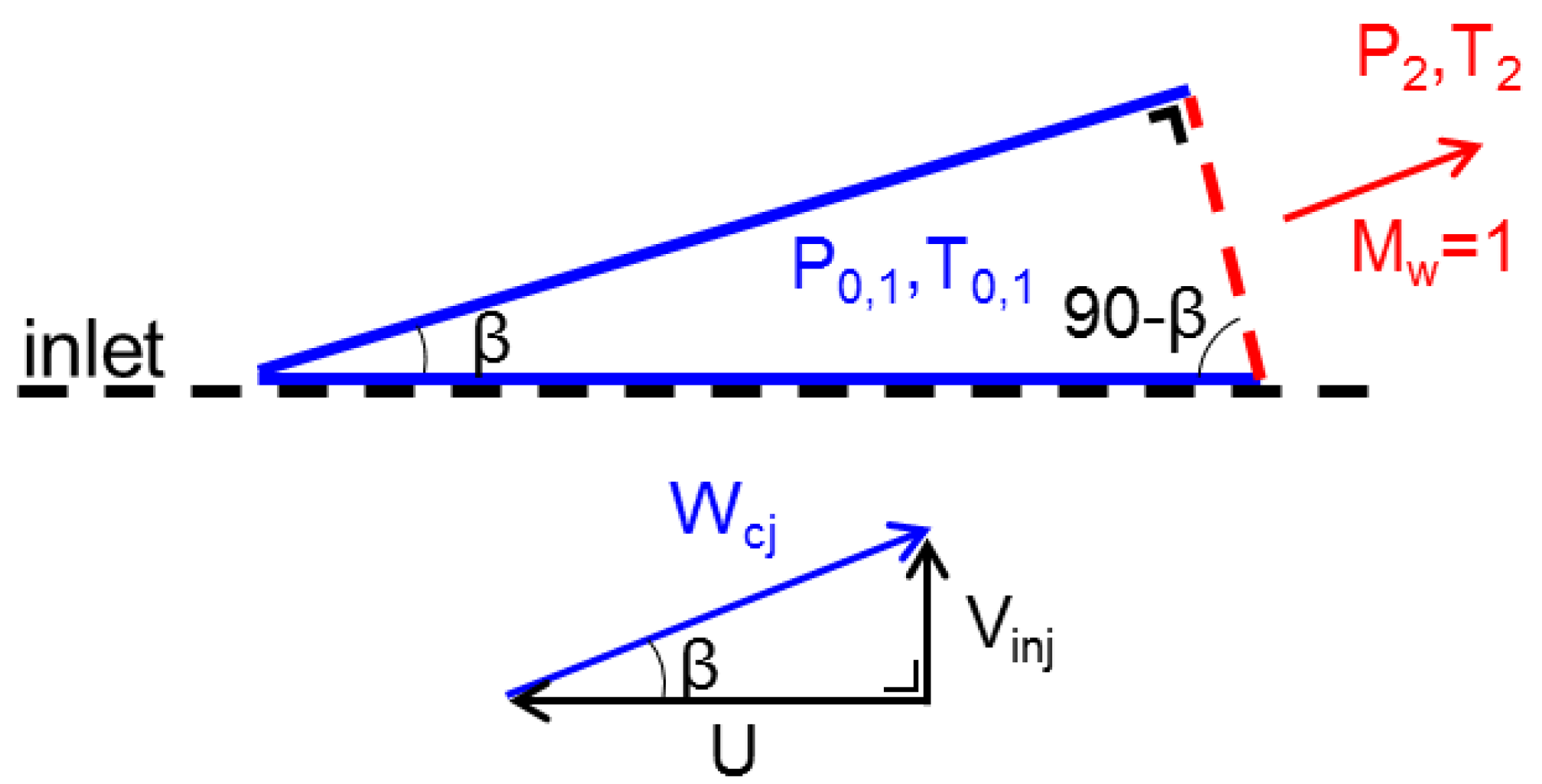
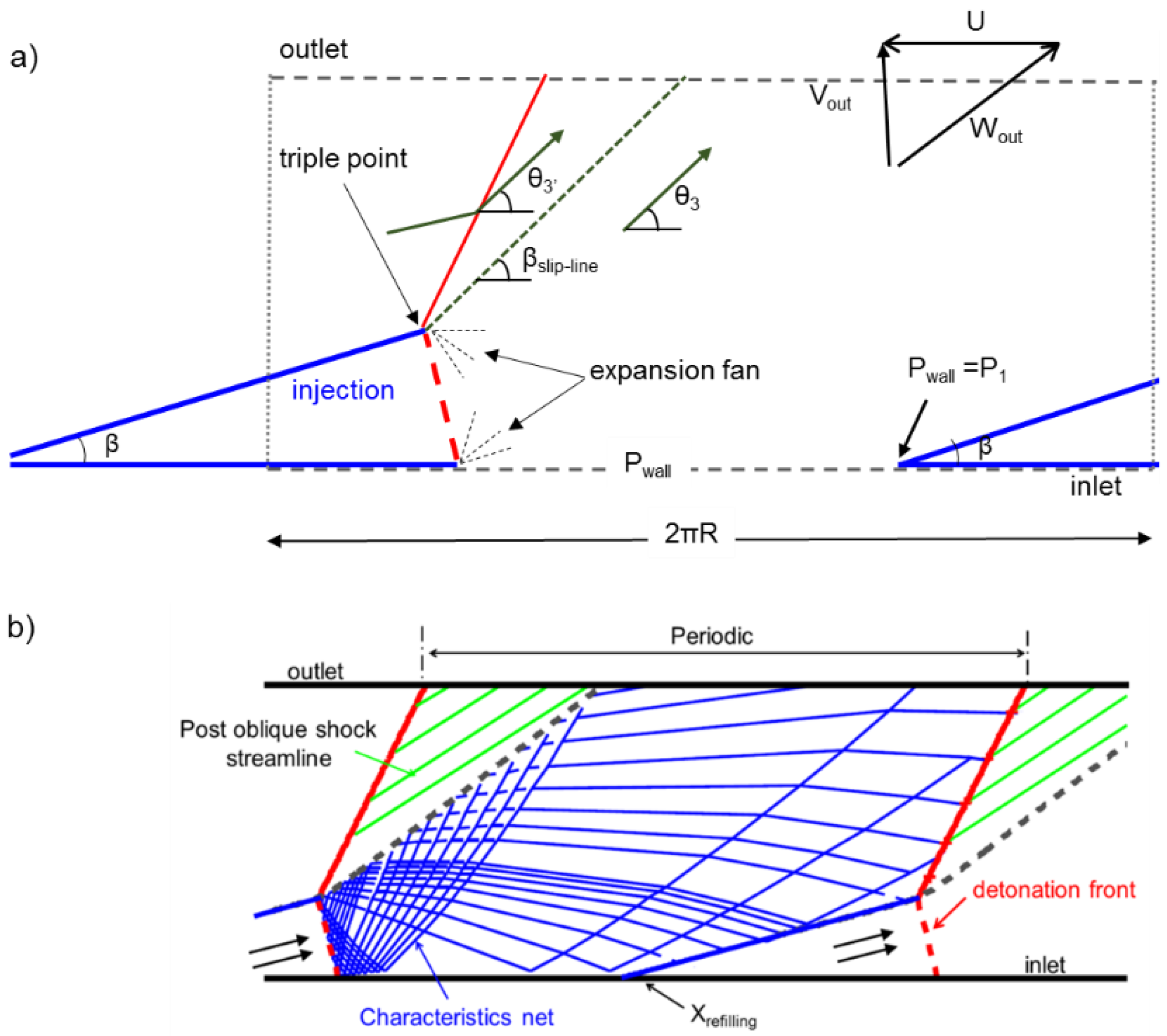
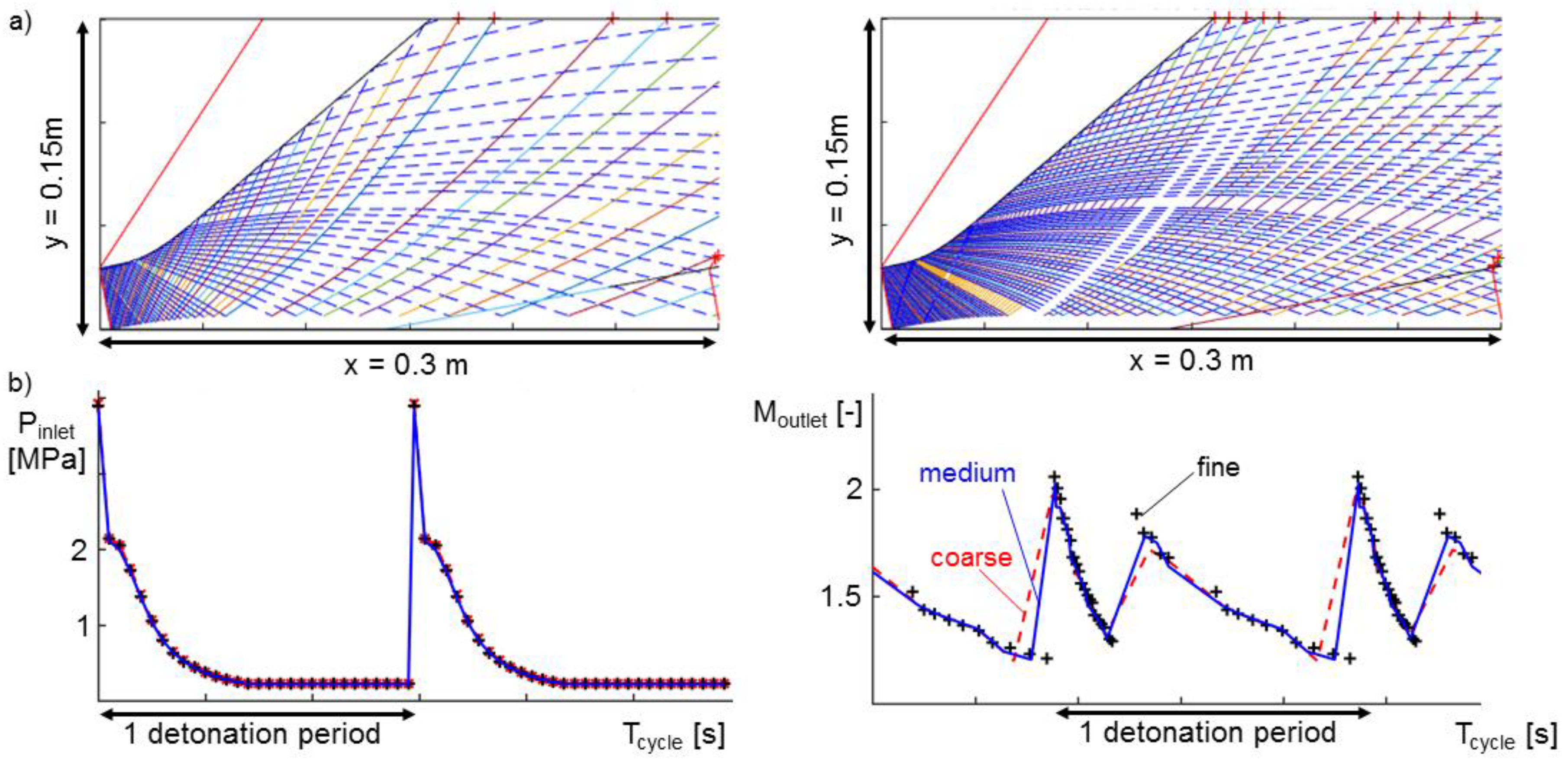
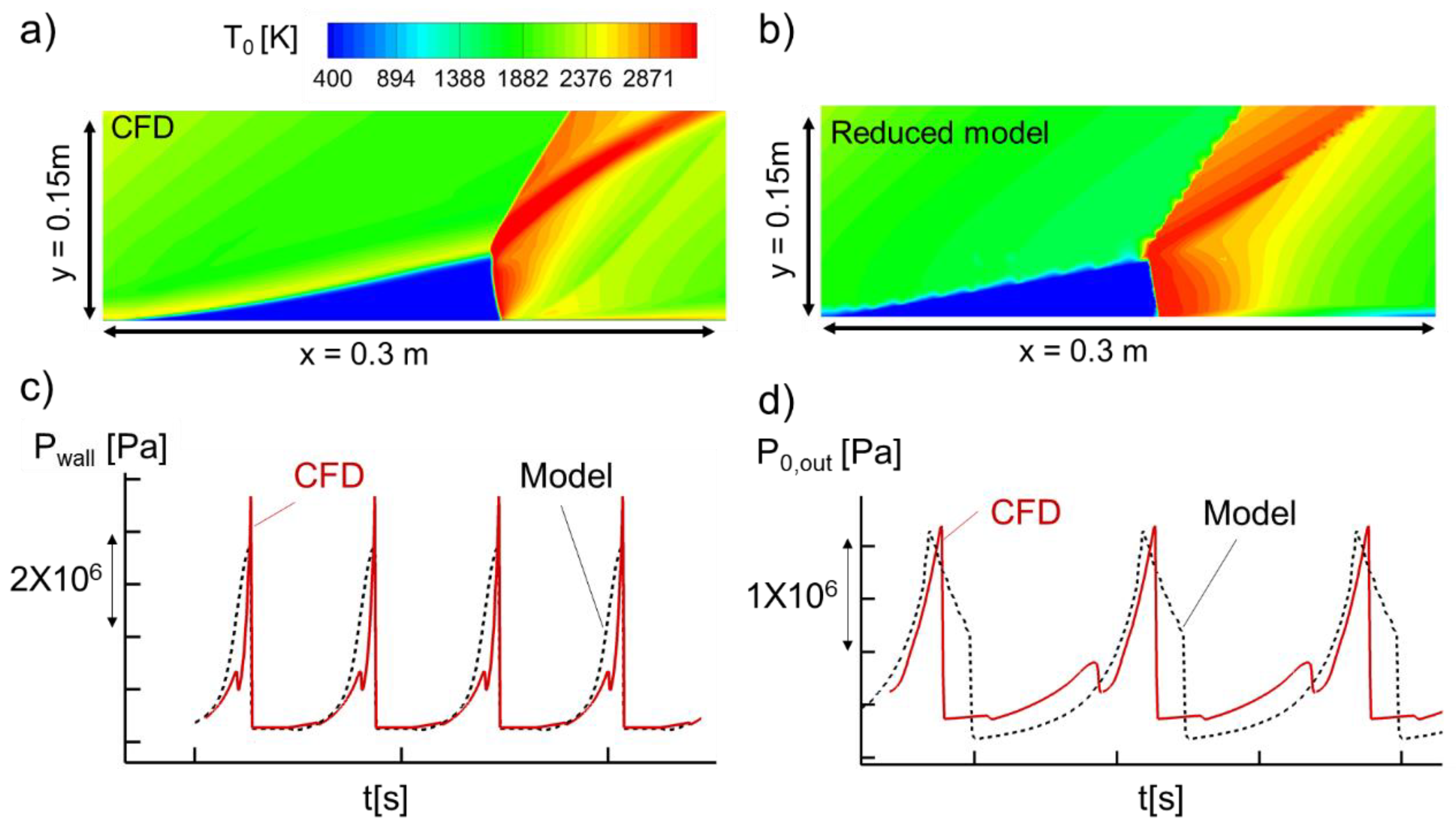



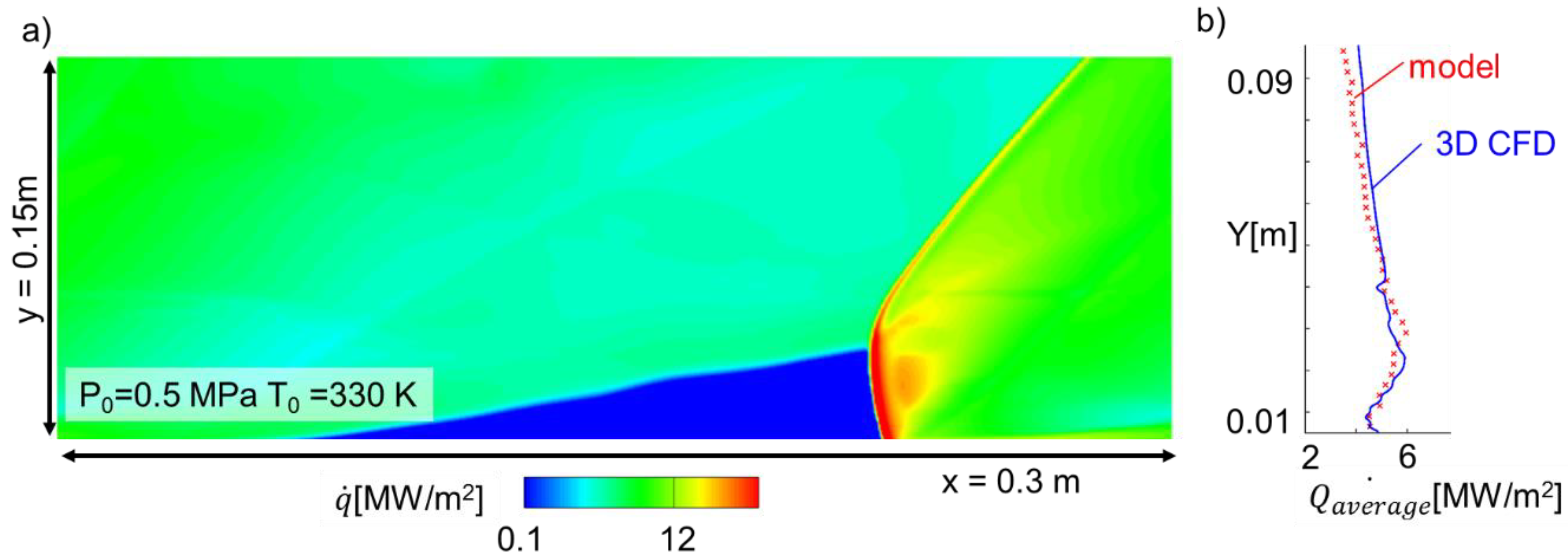
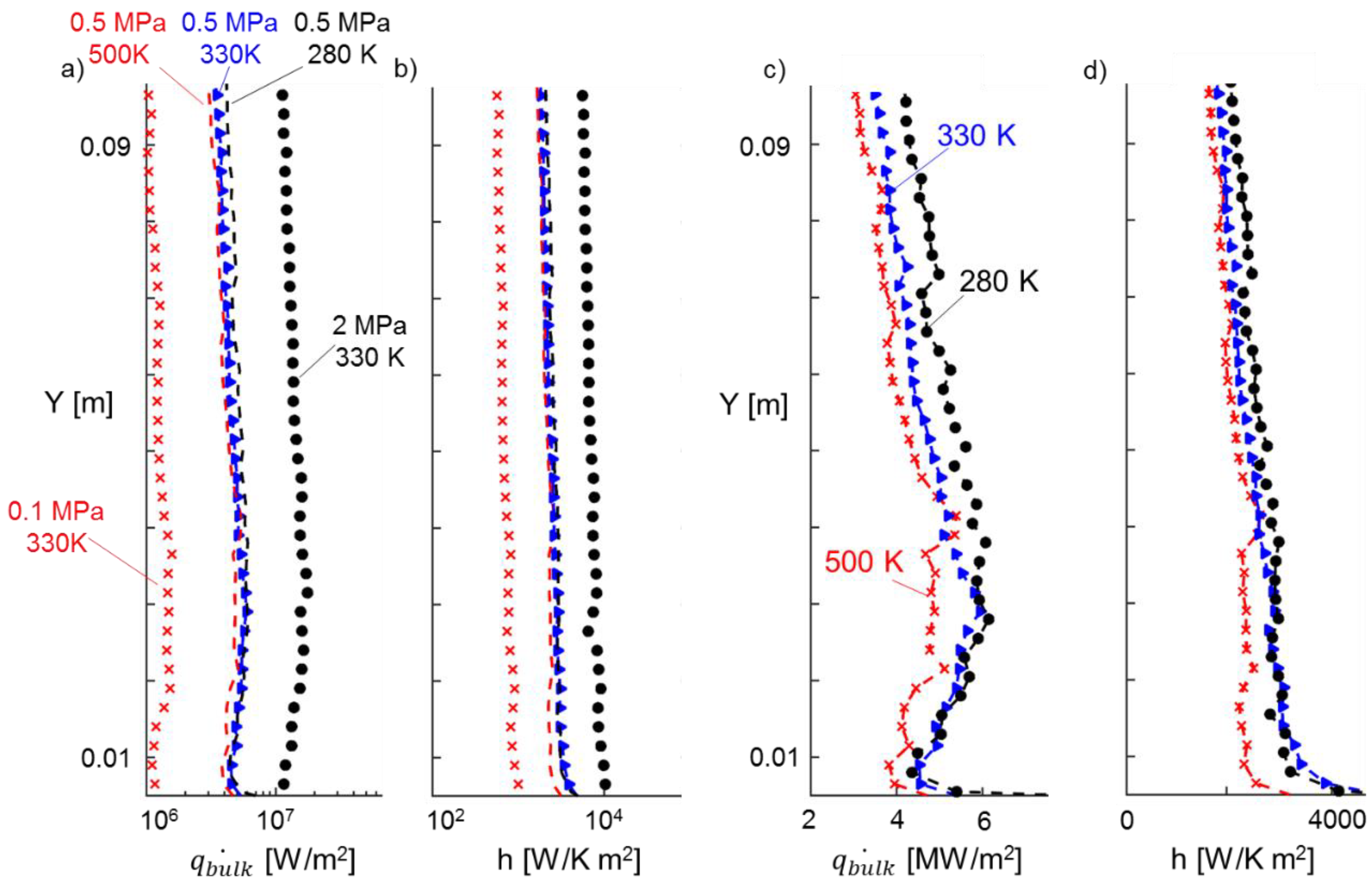
| Tref | σviscosity,ref | Cteviscosity | kref | Ctethermal conductivity | |
|---|---|---|---|---|---|
| H2 | 273.16 | 8.45 × 10−6 | 66.8 | 0.17290 | 175.3 |
| O2 | 273.16 | 1.92 × 10−5 | 125.0 | 0.02449 | 268.8 |
| N2 | 273.16 | 1.656 × 10−5 | 104.7 | 0.02407 | 178.1 |
| H2O | 273.16 | 1.006 × 10−5 | 523.3 | 0.0161 | 1276.0 |
© 2018 by the authors. Licensee MDPI, Basel, Switzerland. This article is an open access article distributed under the terms and conditions of the Creative Commons Attribution (CC BY) license (http://creativecommons.org/licenses/by/4.0/).
Share and Cite
Braun, J.; Sousa, J.; Paniagua, G. Numerical Assessment of the Convective Heat Transfer in Rotating Detonation Combustors Using a Reduced-Order Model. Appl. Sci. 2018, 8, 893. https://doi.org/10.3390/app8060893
Braun J, Sousa J, Paniagua G. Numerical Assessment of the Convective Heat Transfer in Rotating Detonation Combustors Using a Reduced-Order Model. Applied Sciences. 2018; 8(6):893. https://doi.org/10.3390/app8060893
Chicago/Turabian StyleBraun, James, Jorge Sousa, and Guillermo Paniagua. 2018. "Numerical Assessment of the Convective Heat Transfer in Rotating Detonation Combustors Using a Reduced-Order Model" Applied Sciences 8, no. 6: 893. https://doi.org/10.3390/app8060893
APA StyleBraun, J., Sousa, J., & Paniagua, G. (2018). Numerical Assessment of the Convective Heat Transfer in Rotating Detonation Combustors Using a Reduced-Order Model. Applied Sciences, 8(6), 893. https://doi.org/10.3390/app8060893




